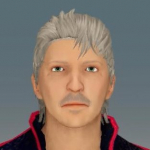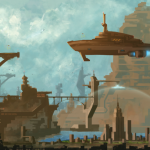By Wang Xiang
Although the world of cryptoart is unfolding at a tremendous pace, it makes sense from time to time to look backwards; art is meant to last. With this article, I would like to pay tribute to some of the cryptoart pioneers. I call them pioneers of the “second wave”, which started in 2018 with the arrival of dedicated marketplaces such as SuperRare. Artists who minted pieces at that time were true adventurers and discoverers of a new creation space, and we can only have admiration for them and be respectful. Here, I have selected five works by five different artists, which I particularly appreciate, and that were created in 2018 or at the beginning of 2019. For me, these are remarkable artworks that will go down in cryptoart history.
—
Obvious Maxxena May 2018
Obvious is an artist collective that made itself known when one of their AI works has been unexpectedly sold for $432,500 at Christie’s in October 2018. It is said that the first contacts with Christie’s were established after they discovered Obvious’ art on the SuperRare platform. The sale generated intense, and sometimes heated, discussions in the art sphere, especially among AI artists.
Spiders are masters of mathematics and architecture. At the time of the creation of this work, the Obvious team met Cedric Villani, a great French mathematician awarded the Fields Medal in 2010, who happens to have a very special passion for spiders and, on this occasion, they had a discussion on machine learning and art that we imagine was fruitful.
In art, spiders are often represented by giant, almost threatening, physical structures. We think of ‘Maman’ by Louise Bourgeois or ‘The Red Spider’ by Alexander Calder for example. But Obvious’ spiders are the opposite of that, immaterial and even declared “defenseless” by its creators. Flying into the blue, almost dissolved in pure virtuality.
Obviously (ಠ‿↼), the piece was named after Maexxna (sometimes misspelled Maxxena), a large spider of the Arachnid Quarter in Naxxramas within the game World of Warcraft. As a wink. As a game. But, by its symbolism, Maxxena is a piece of ‘igneous art’. Isn’t our soul the spider that spins our own body? And will this spider (Aranea in Latin) help us find Ariadne’s thread to exit this labyrinth?
—
Max Osiris Salvator Oeconomia August 2018
We don’t need to introduce Max Osiris. Admired, sometimes hated, he leaves no one indifferent. His abundant, sparkling, exuberant art is constantly evolving, at an incredible speed. Following his artistic journey is fascinating. Max Osiris is an early cryptoartist who marked, marks and will mark the cryptoart movement.
‘Salvator Mundi’ by Leonardo da Vinci is the most expensive painting ever sold at a public auction. Max Osiris took an image of this painting and replaced Jesus’ eyes with those of other subjects, giving birth to the (in)famous ‘Salvator’ series, which includes ‘Salvator Oeoconomia’. An important feature is the blurring of 90% of the image and, as the artist says, “this somehow makes it difficult to tell which hand gesture Jesus is actually making, and about what and to whom¯\_(ツ)_/¯.”
In a certain way, Max Osiris’ artwork echoes the veil of women, dominator culture and censorship. More broadly, it can also be interpreted as a critique of our current society, and especially the economic and financial system on which it is built. In this work, Jesus’ eyes have been replaced by those of Vitalik Buterin who, as the creator of Ethereum, is displayed as a savior of our economy – Salvator Oeconomiae.
Despite – and maybe because – of the context of this work, ‘Salvator Oeconomia’ transmits inner peace, serenity and certitude. If the eyes are the mirror of the soul, here this mirror is the one of a consciousness that expresses, without any word, the inexpressible.
—
Hex6c Genesis Block October 2018
Hex6c is a data scientist and generative artist who entered the cryptoart scene in June 2018. His artistic nickname and his works reflect his dual nature, rational and spiritual. Hex6c is also known for his detailed statistical studies and analysis on cryptoart. Also, the famous piece ‘Warhol’, developed with Hackatao, is considered to be one of the very first collaborative works in this space.
A hash is basically the reference number of a block in a blockchain. Hex6c has developed a way to map any hash “into a unique coilgram made of intertwined coils with different shapes and colors. Hashes are used as random number generators to determine the shape and color of the coils.” ‘Genesis Block’ is a coiled representation of the Genesis block of the Ethereum blockchain.
However, ‘Genesis Block’ is much more than “rules” and algorithms. Yes, we can use numbers to tell the difference between blue and red if we explain colors in terms of vibrations; but nothing can replace the real nature of blue or red. The qualitative experience always transcends the quantitative knowledge, and our personal experience demonstrates it: ‘Genesis Block’ is a vibrantly magnetic work of art, where the imagination and the creative spirit of the artist manifest themselves.
‘Genesis Block’ has a black background, and I call it the ‘Yin version’ of the coilgram. It was this version that was first minted on KnownOrigin. Later, a ‘Yang version’ of the same block – with white background – was created on SuperRare. Both have a nice story to tell us: the path is long and tortuous but it is engaging. “If the path is beautiful, let us not ask where it leads.”
—
David Young Learning Nature (b31, 2086, 13) November 2018
David Young, also known as Triplecode, explores the possibilities of seeing new patterns at the edge of art and science. He collaborates with artificial minds that feel the urge to create art because this is what they have been designed for.
David Young indicates he was inspired by the Hudson River School, a 19th century art movement that used painting to express man’s relationship with nature. This work is one of a series called ‘Learning Nature’ that depicts flowers emerged from his “collaboration” with an AI trained with photographs the artist took at his farm in Bovina, NY.
David Young says: “We’re anxious, yes, but we are anxious because we want to deny that the work speaks to some inner sense of beauty that we cannot resist.” He is an AI researcher acting like an alchemist who seeks to create gold from base metal. Slowly, after having thoroughly mixed the appropriate components and gone through numerous distillations, the precious object appears and the artist knows how to recognize and preserve it.
This flower doesn’t exist in the real world and yet it had always existed as an un-manifested possibility in the depths of a network that is learning about nature, and now it is revealed. Vision is a bit blurred because our eyes are not trained to see such things. As Jonathan Swift said, “vision is the art of seeing things invisible.”
—
Bard Ionson Bright Land December 2018
Far from kitsch and compromises, Bard Ionson pursues his own artistic journey, through artificial intelligence and oscilloscopes, with works infused with backstories and hidden layers of meaning. As he says, he is fascinated with the space between the electronic and spiritual worlds and the distortions that happen upon passing between them.
Bard Ionson made me discover oscilloscope art. At the intersection of two art forms, visual art and music, he is, with Jerobeam Fenderson, one of the most compelling artists in this domain. Many of his works have explored the possibilities offered by oscilloscopes, and this is quite unique within the cryptoart movement.
This work is at the conjunction of AI and oscilloscope art. The artist trained a machine learning neural network with a set of nude paintings and then ran an epoch of oscilloscope art. As the artist says, it is “a bright land between worlds, an imaginary place in the mind of a neural net where organic figures dance in the neon light.” Or do they dance in a digital forest?
Listen. Listen carefully. Don’t you hear the song from the digital forest? Searching for the symbiosis between the external being and the internal, abstract one as it is codified in a system of machines. And looking for this harmony with Gaia – “the spirit of nature” – so that nature, man and artificial intelligence become one.
—
Oficinas TK Still Life February 2019
Oficinas TK is especially fond of hermetism and geometry. For his art, he generally chooses simple and unpretentious themes but he perfectly knows the secret of things and how to convey their subtle messages. He is also the founder of the Thoreau Center for the Blockchain Arts (TCBA) that promotes and preserves the works of many cryptoartists. With this in view, virtual exhibition spaces have been built both in Cryptovoxels and Decentraland.
Still-Life has always been a popular art form and it has been revived more recently by artists such as Andy Warhol, Roy Lichtenstein or Keith Haring. This artwork by Oficinas TK presents a golden apple and, blurred in the background, the image of a work by Max Osiris titled ‘Je rêve dans les coeurs’ that takes its source in the portrait of the ‘Comtesse de la Tour-Maubourg’ by Théodore Chassériau.
But, here, she is not a countess anymore. She has vanished and has been transformed into a composite personage. The golden apple in the foreground solidifies the whole composition. This is a perfect fruit that could well have been picked in the garden of the Hesperides. It is as if, under the effect of a strange alchemical operation, the golden apple had allowed the countess to transmute into this strange double-headed being.
The apple is an enigmatic and ambiguous symbol that unites antagonistic messages and has many different significations. The apple is everywhere and continues to fuel the collective imagination until today. The name of a well-known technology brand is just one of the most recent examples, and it will not be the last. The apple is eternal.
—
Let us be guided by the clairvoyance of the look and the radiance of the heart.

Wang Xiang
Virtual & Digital



Wow. Thank you for such a well written article!
Your point of view is eye opening for us who didn’t get to experience the beginnings of this incredible platform and the crypto art world per se.
Congrats!
Such intriguing concepts. Older traditional artist seeking kindly access to this while new world.